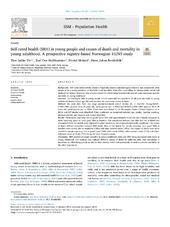| dc.description.abstract | Background: Self-rated health (SRH), which is frequently used in epidemiological research, has consistently been shown to be a strong predictor of morbidity and mortality, even after controlling for demographic, social and medical risk factors. However, less is known about the relationship between SRH and all-cause and cause-specific mortality in young adulthood. Objective: To investigate SRH in young people (13–35 years-old) as a predictor of all-cause mortality in young adulthood (deaths before age 54) and examine the associated causes of death. Methods: We used data from two large population-based cohort studies (N = 23,679): Young-HUNT1 (1995–1997, persons 13 to 20 years old, participation rate = 90%) and HUNT2 (1995–1997, persons 20 to 35 years old, participation rate = 70%). These data were linked to the Norwegian Cause of Death Registry up to 2014, and 247 deaths were identified. Other predictors we examined included age, gender, baseline smoking, physical activity and physical and mental disability. Results: Participants reporting ‘not so good’/‘poor’ SRH had approximately twice the risk of death compared to those reporting ‘good’ or ‘very good’ SRH at baseline. The association between low SRH and risk of death was attenuated when the models were adjusted for other predictors, but remained statistically significant. The causes of death differed somewhat between SRH levels. Most of the deaths for people reporting ‘very good’ SRH at baseline were mostly due to neoplasms (34%) and other external causes (30%). The causes of death were more varied for people reporting ‘not so good’/‘poor’ SRH, with suicide (23%), other external causes (21%) and other/unknown causes of death (17%) being the most frequent causes. Conclusion: SRH predicts all-cause mortality in young adulthood, with poor SRH being associated with death in young adulthood. The findings also indicate different causes of death for different SRH. This knowledge is important for identifying groups at risk for later disease, which can potentially be used to prevent morbidity in the adult population. | en_US |

